Posted by James (admin) on 8th October 2012
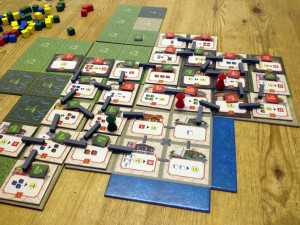 Singapore is an interesting mix of tile-laying and economic/resource management. Players are aiming to score the most victory points (VPs) which are earned through moving your worker(s) and using buildings. The board consists of several sections which can be combined in many ways which gives some variety in replay. Most squares on each board section show the cost of building on that square (£1-£4) . At the start of the game, there are 4 neutral buildings – every round players build one building and connect them to neighbouring buildings.
Singapore is an interesting mix of tile-laying and economic/resource management. Players are aiming to score the most victory points (VPs) which are earned through moving your worker(s) and using buildings. The board consists of several sections which can be combined in many ways which gives some variety in replay. Most squares on each board section show the cost of building on that square (£1-£4) . At the start of the game, there are 4 neutral buildings – every round players build one building and connect them to neighbouring buildings.
Players start with some money, 5 VPs and one worker. At the start of each round, a number of buildings are revealed (equal to the number of players plus one). Then, the player in last place takes one coloured marker from each player and places them on vacant lots that neighbour any existing buildings. These markers show where each player will build a building that round and the cost on the square dictates how much it will cost them.
Starting with the player in last place (and then going clockwise), players select one of the available buildings and pay the cost to build it on their marked square (leaving their coloured marker on it to show they own it). If a player can not afford the building cost, they must exchange 1 VP for £2 until they can (or they get the building for free if they have no cash and no VPs).
Read the rest of this entry »
Tags: board game news, Board Games, board gaming, Peer Sylvester, Singapore, White Goblin Games
Posted in Board Game Review, Board Games, Singapore | 4 Comments »
Posted by James (admin) on 7th October 2012
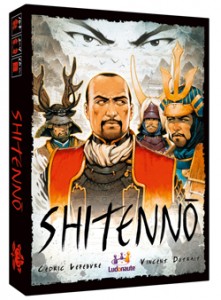 Recently, I reviewed Shitenno and mentioned I thought it would work well as a 2-player game. Since then, I had the chance to try this out and I’m pleased to say it does work well with 2 players as there are fewer combinations of cards and outcomes to try to consider so you can make a more informed decision. Rather than having to make one offer of cards at a time, with two players it is a simple one-player-splits-whilst-the-other-chooses process.
Recently, I reviewed Shitenno and mentioned I thought it would work well as a 2-player game. Since then, I had the chance to try this out and I’m pleased to say it does work well with 2 players as there are fewer combinations of cards and outcomes to try to consider so you can make a more informed decision. Rather than having to make one offer of cards at a time, with two players it is a simple one-player-splits-whilst-the-other-chooses process.
Compared to the 4-player game, I found I could better work out which cards I wanted, plus I had more insight into which cards I didn’t want my opponent to have too. Even with this knowledge, creating a balanced offer of cards/role so that my opponent didn’t automatically take the offer I that really wanted still remained enjoyably difficult. Also, selecting which role is offered with each group of cards is made more interesting because the person making the offer only uses 2 of the 4 roles each turn – in fact, I think I had more difficulty choosing which roles to offer than splitting the cards (in a good way as it was an interesting choice to make).
The inherent downside to a directly competitive 2-player game is that what you lose the other player gains and vice versa (a kind of ‘tug-of’war’ play pattern), and you only need to watch a single opponent. I was thinking that an invisible 3rd player would be good to make things a bit more ‘lumpy’ – I’ve noticed over the years, I like an invisible 3rd player in 2-player game (Alhambra was my first experience of it) but just so long as it is slightly predictable and not purely random. If it’s totally random, one player can suffer through no fault of their own just because they had no way to include the 3rd player’s actions into their plans, and this unbalances the game.
Read the rest of this entry »
Tags: board game news, Board Games, board gaming, Shitenno
Posted in Board Games, Shitenno, Thoughts On | No Comments »
Posted by James (admin) on 3rd October 2012
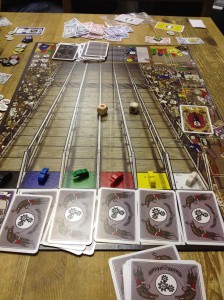 I’m usually a bit skeptical about horse racing games as I find they can be quite dry and/or overly complicated; however, Horse Fever surprised me. In Horse Fever, each player is trying to earn as many victory points (VPs) as possible.
I’m usually a bit skeptical about horse racing games as I find they can be quite dry and/or overly complicated; however, Horse Fever surprised me. In Horse Fever, each player is trying to earn as many victory points (VPs) as possible.
Each round, players get cards, make a bet, play cards on horses (without revealing them), make another bet, reveal the cards and then the race takes place. In the simpler version of the game that we played players are dealt cards – some cards help horses (they get a good start, move further when sprinting, etc.) and some hinder horses (they don’t move when in the lead, all beneficial cards are ignored, etc.) In the full version of the game, players buy cards instead of bring dealt them (which I think would be the best way) – you can also get target cards (extra VPs if you meet the conditions at the end of the game), assistant cards (discounts on some cards, regular income, etc.), stable cards (you own a horse and get cash if 1st, 2nd or 3rd), horse cards (on-going benefit to your horse if you have a stable). You can also take out loans and buy cards from other players. Read the rest of this entry »
Tags: board game news, Board Games, board gaming, Horse Fever
Posted in Board Game Review, Board Games, Horse Fever | 3 Comments »
Posted by James (admin) on 1st October 2012
A few more forthcoming games that have taken my interest recently. (I’ve combined all the Spiel games on my radar on my Essen 2012 page too.)
Tzolk’in: The Mayan Calendar (Czech Games Edition)
Tzolk’in is a game where the turning of cogs are at the very centre of a worker placement game. Players place workers on small cogs which are located around a central, large cog. The large cog is turned as the game progresses and this turns the small cogs. Players spend corn to place their workers (filling the cheapest slot) on the cog where they want to place a worker. When a player, removes a worker, they get a benefit based on where they player is on the cog – the longer they remain on a cog, the greater the benefit. One cog has an interesting element to it where a player can take corn even if it is not quite ready but at the risk of angering the gods. There’s still a lot of information to come about this game but, so far, it sounds really interesting.
1969 (Cranio Creations)
A resource gathering, dice-rolling and card playing game where players are trying to reach the moon in a space race before 1969. Players gather scientists, cash and intelligence cards to prepare for different missions. They only get one chance at each mission which scores VPs. To undertake a mission the player rolls the 5 dice (and moves an appropriate number of spaces along the mission track); however, then all players get to play intelligence cards that move the active player back down the track (and the active player gets to play cards to move themselves forwards) – all cards are played simultaneously. The biggest mission is the moon mission and completing any other mission means a player can start further along the moon mission track. Sounds very good (reminds me slightly of Airships by Queen Games – a game I really like – not through any specific game mechanic, but just in trying to prepare to achieve tasks).
Check out the details and rules at Cranio Creation’s web site: bga.me/1969
Blackrock City (Blackrock Editions)
Blackrock Editions published a great game called The Boss a couple of years ago. This year they are releasing Blackrock City – a wild west game where players bid their outlaws. The winner of a round moves their outlaw chief a number of spaces (equal to their bid minus the lowest bid) and takes gold from the city they land on. The player who is second in a round gets a silver from the stagecoach. However, there are some interesting twists: the outlaws you bid with have a limited usage; players can not bid the same as the leading bid; each bid moves the sheriff around the cities which foils outlaws; and, cities have different effects after they have been robbed.
It sounds like a short, fast bidding game but with some interesting thinking around the bidding as players try to work out how to win rounds (or at least move the sheriff to annoy others) whilst positioning their outlaw on a beneficial city. One interesting feature is that, twice per game, each player can place a 15 second sand timer in front of an opponent and that player must take their go in that time. Also, I like how it plays 2-player with an invisible 3rd player.
Check out the details and rules at Blackrock Edition’s web site: bga.me/brc
Tags: 1969, Blackrock City, board game news, Board Games, board gaming, Essen, Spiel 2012, Tzolk'in
Posted in 1969, Blackrock City, Board Games, Essen Spiel 12, On the Radar, Tzolk'in | No Comments »
Posted by James (admin) on 27th September 2012
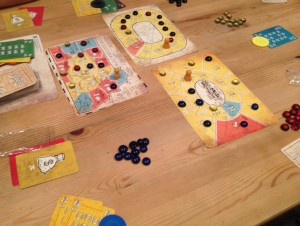 I like the idea of using poker hand mechanics in a game. At Spiel 2011, I played a game that used poker hands but it turned out to be average so I was really intrigued when, just 5 minutes later, I noticed Montana on the Cambridge Games Factory. With a cheap price, I decided to pre-order it and it arrived a couple of months ago.
I like the idea of using poker hand mechanics in a game. At Spiel 2011, I played a game that used poker hands but it turned out to be average so I was really intrigued when, just 5 minutes later, I noticed Montana on the Cambridge Games Factory. With a cheap price, I decided to pre-order it and it arrived a couple of months ago.
Montana is an area control game where players compete for control over 3 areas each round, and the player with the most victory points (VPs) at the end of the game wins. Players score VPs for (a) areas they control with a bonus for having multiple connected regions, (b) if they control their secret objectives, (c) if they control the most red regions, and (d) if they control the most blue regions.
Players start the game with some cards (numbered 1-12 in five colours x 2) as well as two secret objectives (for which they’ll score extra points if they control that specific region). On the table are 3 boards with 16 regions on each. At the start of each turn, one player chooses which region will be contested on the main board (the other two boards are contested in numerical sequence). Read the rest of this entry »
Tags: board game news, Board Games, board gaming, Montana
Posted in Board Game Review, Board Games, Montana | No Comments »
Posted by James (admin) on 25th September 2012
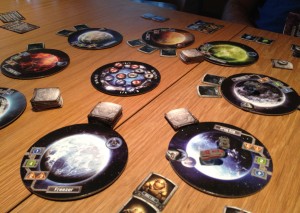 Space Mission is a simple, space-themed game of planetary exploration, but there’s more to it than it first sounds. The goal is to score as many victory points (VPs) as possible which are scored by collecting sets of tiles from the planets and some other ways. On the table are 8 planets each with 8 face-down tiles, and a warp gate in the centre. Each player has a spaceship and starts with a hand of 5 cards. Each card has two numbers on it from 1 to 4 (or a ? which counts as any value) and each number is either green, orange or blue. On their turn, a player can carry out 2 actions (including the same one twice). The 6 actions are:
Space Mission is a simple, space-themed game of planetary exploration, but there’s more to it than it first sounds. The goal is to score as many victory points (VPs) as possible which are scored by collecting sets of tiles from the planets and some other ways. On the table are 8 planets each with 8 face-down tiles, and a warp gate in the centre. Each player has a spaceship and starts with a hand of 5 cards. Each card has two numbers on it from 1 to 4 (or a ? which counts as any value) and each number is either green, orange or blue. On their turn, a player can carry out 2 actions (including the same one twice). The 6 actions are:
- Jump: Discard a card with a blue number and move your spaceship directly to a planet with the same blue number. Place one of your coloured markers on the warp gate.
- Scan: When at an undeveloped planet, discard a card with a green number that matches the planet’s green number to look at that planet’s tiles and reserve one (which you get if the planet gets developed)
- Develop: When at an undeveloped planet, discard two cards with orange numbers that match the planet’s two orange numbers to develop it. Anyone who has scanned and reserved tiles at that planet now receives them, and the developing player takes a tile from the stack too.
- Discover: At any developed planet, take one of the tiles. This action doesn’t cost any cards.
- Fly: Move your spaceship to one of the two planets neighbouring your current location. This action doesn’t cost any cards.
- Draw cards: Discard any cards you want and draw back up to 5 cards. This is the only way to get new cards. Read the rest of this entry »
Tags: board game news, Board Games, board gaming, Space Mission
Posted in Board Game Review, Board Games, Space Mission | No Comments »
Posted by James (admin) on 21st September 2012
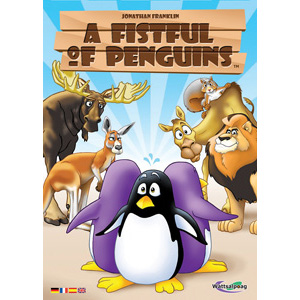 A Fistful of Penguins consists of lots of very cute, clear plastic penguins and some dice which have different animals on each face. On their turn, a player starts by rolling 4-6 dice (depending on which of the 3 rounds it is). After their roll, a player can either (a) stop rolling and cash in their roll, or (b) they can spend one of their penguin pieces to either re-roll any of their rolled dice, or they can roll 1 new dice and add it to their rolled result. Players start with 6 penguins so these options are open to them from the start of the game. Players can keep adding dice and/or re-rolling if they have the penguins to pay for it.
A Fistful of Penguins consists of lots of very cute, clear plastic penguins and some dice which have different animals on each face. On their turn, a player starts by rolling 4-6 dice (depending on which of the 3 rounds it is). After their roll, a player can either (a) stop rolling and cash in their roll, or (b) they can spend one of their penguin pieces to either re-roll any of their rolled dice, or they can roll 1 new dice and add it to their rolled result. Players start with 6 penguins so these options are open to them from the start of the game. Players can keep adding dice and/or re-rolling if they have the penguins to pay for it.
When a player decides to stop rolling, the receive an income based on the various animals they have rolled: Penguins, Lions, Camels, Kangaroos, Squirrels and Moose (1 of each animal on each dice).
- Penguin results earn penguin pieces – you can even cash in dice with penguins on during your turn; however, the more penguins cashed in together, the more penguins the player receives.
- Squirrels mean other players have to give you money in turn order and more squirrels means more money.
- Moose are worth $9 each if they are paired with a squirrel (instead of the normal squirrel effect).
- Kangaroos are worth their total number squared in dollars. If you score kangaroos in the first and/or second round, you get to turn one or two of your dice into kangaroos in the third round.
- Lions are worth $7 each, but if you choose to score lions means only lions and penguins count (and all other animals are worthless).
- Camels are worth $5 each, but $0 if any lions are showing (even if you don’t score them). Read the rest of this entry »
Tags: A Fistful of Penguins, board game news, Board Games, board gaming
Posted in A Fistful of Penguins, Board Game Review, Board Games | 2 Comments »
Posted by James (admin) on 18th September 2012
Couple of new games that have taken my interest recently. (I’ve combined all the Spiel games on my radar on my Essen 2012 page too.)
Desperados (Argentum Verlag)
I like Argentum Verlag as they have released the extremely funny and backstabby Lifeboats as well as the excellent eurogame Hansa Teutonica. This year it’s the Wild West and the game is Desperados. All the players but one are the villains working together against the player who is the marshal and controls the sheriffs. The players move their villains using a secret movement system by laying location cards face-down – this includes the marshal player too. That element reminds me how Dracula moves in Fury of Dracula.
When 5 moves have been ‘programmed’, they get resolved. An outlaw player in the same location as a marshal gets arrested, is in jail for the remainder of the round, and losses that location card for the rest of the game. If there are more outlaw players at a location than sheriffs then they can fix a poker game, rob a bank or hold-up a stage coach if there is one. The two stage coaches move along pre-programmed routes. The outlaw players win if they net $4,000 per player or more. I’m not sure about the win condition as it sounds a bit plain; however, Desperados sounds like a great mix and is definitely one I want to try. The rules are online on their web site.
Check out the details and rules at Argentum Verlag’s web site: bga.me/desperados
Crash’em (Wacky Works)
A demolition derby game with players programming moves in a similar way to RoboRally but only programming 3 moves ahead. I always liked the idea of RoboRally but the execution was always a bit disappointing as it took so long to resolve the moves and any one hiccup (like being pushed by an opponent) could destroy your race. However, Crash’em only has 3 programmed moves each move, which should make it more controllable, plus the whole idea is to bash into people (rather than RoboRally being a race requiring accuracy) so should be much more suited to this type of gameplay. No rules out yet but it’s another one I want to try out.
Tags: Argentum Verlag, board game news, Board Games, board gaming, Desperados, Essen, Spiel 2012
Posted in Board Games, Crash'em, Desperados, Essen Spiel 12, On the Radar | No Comments »
Posted by James (admin) on 17th September 2012
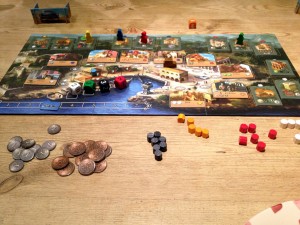 There are some designers that seem to be more stealthy than others – you know, the ones that one day you suddenly notice you’ve got a lot of games by them but never realised it as you acquired them. Michael Rieneck is one of those for me – he’s designed games such as Cuba, Havana, Dracula, Fortuna, Palastgeflüster.
There are some designers that seem to be more stealthy than others – you know, the ones that one day you suddenly notice you’ve got a lot of games by them but never realised it as you acquired them. Michael Rieneck is one of those for me – he’s designed games such as Cuba, Havana, Dracula, Fortuna, Palastgeflüster.
Santiago de Cuba is a hard game to fit into a single genre because it mixes several elements together and does so well. Players earn Victory Points (VPs) by delivering goods (tobacco, sugar, citrus fruit, rum and cigars) to the waiting ship, and the player with the most VPs at the end wins. The board shows a port town with a ring of 9 different Cuban characters and the dock as well. On their turn, a player moves the car piece clockwise around this ring – moving one space forwards is free, but costs 1 peso (cash) for every extra space after that.
Wherever the player stops the car, they get to use the Cuban at that space and then get to use one of the buildings associated with that Cuban; however, it is more clever than it sounds. Most Cubans allow the player to do things like gain resources (tobacco, sugar, citrus fruit, wood), VPs and pesos. Each Cuban has one of 4 coloured roses on their tile too – once the player has used the Cuban’s ability, they must move their playing piece to a building that has the same coloured rose (and that is not occupied by another player). The player can then use that building’s ability such as make rum and cigars from sugar and tobacco, exchange goods, convert rum and cigars into VPs, turn one ship’s demand dice to zero, reduce/extend the time the ship will stay (which dictates the value of any goods delivered), and more. Read the rest of this entry »
Tags: board game news, Board Games, board gaming, Michael Rieneck, Santiago de Cuba
Posted in Board Game Review, Board Games, Santiago de Cuba | No Comments »
Posted by James (admin) on 14th September 2012
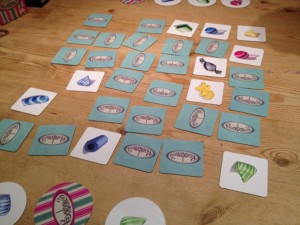 When I was young, I used to play a memory game (like we all probably did) where playing cards were laid out face-down and you turned over 2 of them to try to find a matching pair. I was surprised that Gameworks’ game Bonbons was based on this premise as it seems such a simple game; however, Gameworks have a great track record and I was pleased to find out there was more to it than I expected.
When I was young, I used to play a memory game (like we all probably did) where playing cards were laid out face-down and you turned over 2 of them to try to find a matching pair. I was surprised that Gameworks’ game Bonbons was based on this premise as it seems such a simple game; however, Gameworks have a great track record and I was pleased to find out there was more to it than I expected.
In the centre of the table are 36 face-down sweet/confectionery/candy tiles: there are 32 different sweets (8 types each in 4 colours) plus 3 tiles showing coins, and 1 tile showing an empty wrapper. Each player takes 4 of the 32 round tiles (which show the same sweets as the square tiles) and places these unseen, face-down in front of them. The winner is the first person who has all the round tiles in front of them face-up.
On your turn, you get to turn over 2 tiles (square or round). If you turn over a matching pair (which would be 1 square tile and 1 round tile), they stay face-up. Most importantly, you can turn over an opponent’s round tile and, if you turn over the matching square tile too, you get to place that round tile in front of you and they get one of your face-down round tiles in return. This stealing of other player’s round tiles really adds some fun to the game and it means you’re not just trying to match your own tiles, but are trying to match anyone’s face-down tiles. It’s funny when you steal someone else’s round tile which they’ve been trying to find, but even funnier to see the look on their face when you give them one of your round tiles that hasn’t been turned over at all yet so they’ve spent lots of time and are back to square one. Read the rest of this entry »
Tags: board game news, Board Games, board gaming, Bonbons, GameWorks
Posted in Board Game Review, Board Games, Bon Bons | No Comments »
 Singapore is an interesting mix of tile-laying and economic/resource management. Players are aiming to score the most victory points (VPs) which are earned through moving your worker(s) and using buildings. The board consists of several sections which can be combined in many ways which gives some variety in replay. Most squares on each board section show the cost of building on that square (£1-£4) . At the start of the game, there are 4 neutral buildings – every round players build one building and connect them to neighbouring buildings.
Singapore is an interesting mix of tile-laying and economic/resource management. Players are aiming to score the most victory points (VPs) which are earned through moving your worker(s) and using buildings. The board consists of several sections which can be combined in many ways which gives some variety in replay. Most squares on each board section show the cost of building on that square (£1-£4) . At the start of the game, there are 4 neutral buildings – every round players build one building and connect them to neighbouring buildings.







